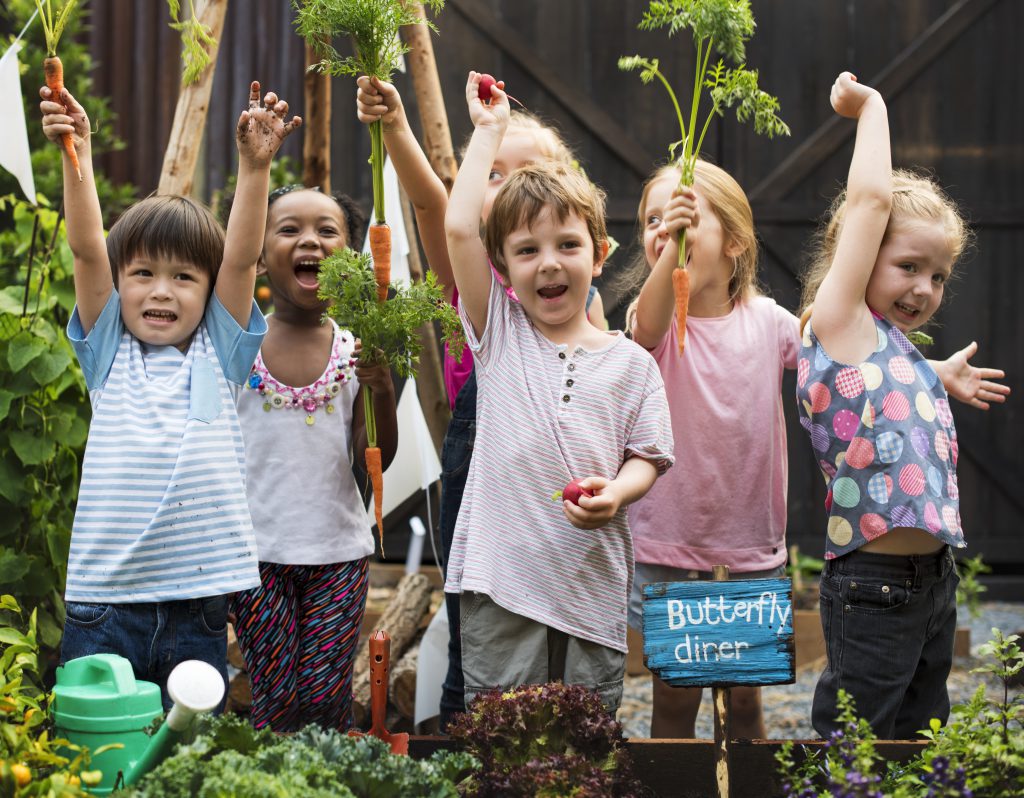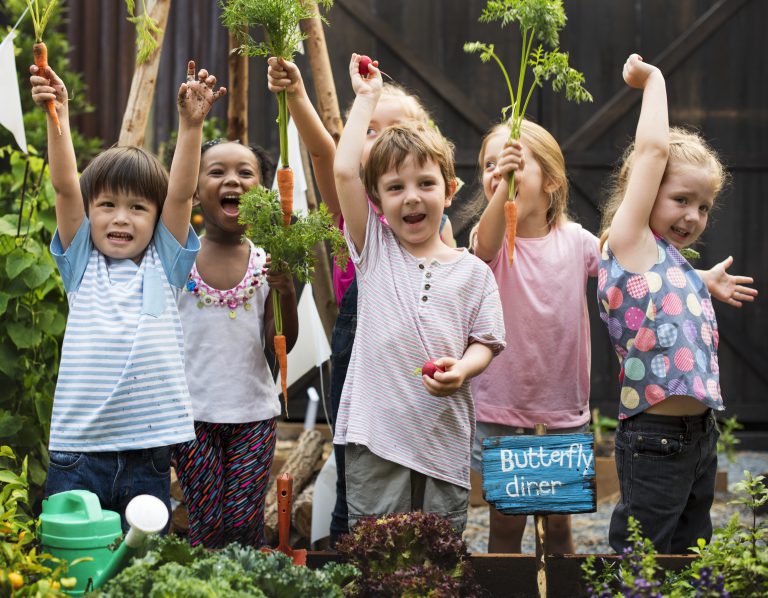I don’t know about you, but I tend to get intimidated when I hear people start talking about gardening. In my mind, I’m reminded of past gardening woes or failed attempts at creating that beautiful, thriving garden I so desperately wanted to have. Or maybe you’ve had success at gardening in the past, but you’re just not sure you have the time or effort to dedicate to a large garden this year.
Wherever your feelings are about gardening, I want to share with you 6 easy steps that you can do this summer to add a little bit of homegrown flavor to your child care program’s kitchen table.

Why Should I Garden?
There are so many reasons that gardening is good for children to participate in! Here are some of my favorites:
Did you know…One study showed that children who participated in gardening activities scored significantly higher in science than other students? Schools with garden programs have higher rates of parent involvement which has been shown to help student achievement. Gardening has also been shown to help students with learning disabilities by increasing their nonverbal communication skills and helping them learn how to form positive relationships and participate in a cooperative effort. Gardens also help to teach children where their food comes from which may make them more willing to try those foods at the kitchen table!
How Do I Start?
1.
Learn about it – did you know you can earn KDHE clock hours by learning about this exact topic? Go NAPSACC has a Farm to ECE module that helps you learn how to find local foods, start a garden in your program, educate families and staff, and even how to write a policy that shares your gardening efforts in your handbook! To get started, reach out to a Child Care Health Consultant today by clicking on “Schedule an Introductory Meeting” CCHC – Child Care Aware
2.
Talk about it – Maybe you don’t have time to grow anything this year but want to still incorporate some of the learning benefits that gardening brings into your program. A great place to start is to talk about it! Ask the children what types of foods they would include in their garden. You can also have them draw that food or what their garden might look like onto a piece of paper. Maybe you choose to have a garden spotlight moment at snack time by eating the food item that each child chose! The options are endless when it comes to conversations about where our food comes from.
If you do choose to have a garden this year and want more curriculum ideas to go along with it, reach out to a Child Care Health Consultant by using the link above!
3.
Plan it out – Now that you have a better idea of what foods interest the children in your program, you can start planning what might be good to grow! This link has some great tips for determining which plants are easiest for kids to grow. What are the Easiest Plants for Kids to Grow in the Children’s Garden? (littlesproutslearning.co)
Need more help? Invite a master gardener to come volunteer at your program! They’re a great resource for education when it comes to knowing what and how to grow. The Kansas Extension Master Gardener program is currently in 72 of our 105 counties. Check here to see if there’s one near you! Kansas County Programs (k-state.edu)
4.
Gather supplies – when it comes to what your garden will look like, try to think outside the box! The easiest gardens are the ones that use the space and materials that we already have on hand. Get creative about different places or containers that you can grow things in. Maybe it’s a small herb pot on the windowsill, or a bag of potting soil in a Rubbermaid container with holes drilled in the bottom. Some supplies you might need include: seeds or seedlings, potting soil, planter pots, watering containers, hand shovels, labels, and gardening gloves. There are lots of affordable ways to gather these supplies, or you can even ask your parents to help! Some more affordable examples include using popsicle sticks for plant labels, an empty milk jug as a watering container, old plastic containers as pots, and seeds from the Dollar Tree. There are even seed donation programs you can check out here Seed Donation Program – Seed Savers Exchange
5.
Recruit help – does your garden require frequent weeding or watering? Talk with your families about getting involved! I’ve heard of programs who have a chore chart where families take turns spending 15 minutes during pick up time weeding or watering. You can also consider the idea of a family work day on the weekend to help you get your garden planted or harvested! Parents should be excited to hear about all of the ways that this garden is enhancing their child’s learning.
6.
Enjoy the harvest –this is, by far, arguably the best step. Even if you had little success with your garden this year, or maybe you didn’t have the time to grow one, you can still bring farm-fresh foods to your program’s kitchen table! Check out your community’s local farmer’s market to find fresh, local produce. You can also look here for farms in your area that you can purchase directly from! Shop Kansas Farms | Brought to you by Kansas Farm Bureau
Source: wholekidsfoundation.org
-

Jessica Gable
Child Care Nurse Consultant, Child Care Aware of Kansas
Jessica works as a nurse consultant from her hometown of Derby. Before joining Child Care Aware of Kansas in 2022, she worked as a pediatric home health nurse. Jessica holds a bachelor’s degree in nursing from the University of Nebraska Medical Center. In her free time, she enjoys being creative with self-portrait photography and trying out new recipes!






